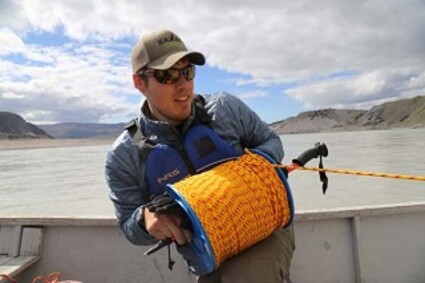Sisters grad works on glacier
Last updated 11/10/2015 at Noon
Fifteen years ago as a Sisters High School junior, Brandon Overstreet, 31, strapped on crampons and picked up an ice axe for the first time. He was a member of the inaugural class of IEE (Interdisciplinary Environmental Expedition) students. Little did he know that that first step onto Hayden Glacier on Middle Sister would lead to groundbreaking research related to climate change.
Last July, he stepped onto the great Greenland ice sheet, one of a team of scientists studying the flow of a supraglacial river flowing into a deep deadly hole called a moulin. For 72 hours, a research team led by Dr. Laurence Smith from UCLA monitored the flow of water into the moulin. Overstreet is working toward his PhD in geography from the University of Wyoming, with an emphasis on geomorphology - the study of how the earth's surface changes over time. His special interest is fluvial geomorphology, or how rivers interact with the earth's surface.
That research or rather the implementing of it (the results are still being studied by the team) - was the subject of a front-page article in the New York Times on October 28. The details of preparing for the study are covered thoroughly in that article. (Read the online version at http://nyti.ms/1LUlZhc.) The online version has received over a million views and the timing coincides with the lead-up to the Paris Climate Change Conference occurring later this month.
Overstreet's contribution to the research is significant. He designed the equipment used for the study and figured out a way to deploy it from a kayak. Using an elaborate system of ropes, similar to that used in swift-water rescue operations, he was able to get the main measuring instrument, an acoustic doppler current profiler which measures the depth and velocity of a river, into the water.
Lance Piatt, the Sisters owner of Rescue Response Gear, helped Overstreet understand the ins and outs of working with ropes and water. The company's library of instructional videos and the hands-on help that Piatt gave were invaluable, Overstreet said.
The fascination with rivers that defines Overstreet's life and profession began as a child in the Okanagan Valley in northern Washington. His parents owned property outside of Tonasket, and the creek flowing through the land kept young Brandon entertained for hours on end. Around age 10 he started noticing that flowing water had a dynamic and was ever changing.
The family moved to Sisters in 1999, and Overstreet and his best friend were at the front of the line to sign up for that first IEE class.
"This had the biggest impact on me," he said. "Studying Whychus Creek, going to the Camp Polk Meadow and discussing how the channel had changed. My scientific interest in water was sparked then."
Through IEE he had the opportunity to walk on the glacier, an experience that stood him in good stead when researchers for the Greenland project were sought. That project was conducted on an ice sheet that is several kilometers thick in places, so some familiarity with moving around on ice was an asset. But before taking part in that, he floated down many miles of swift water in his kayak, honing his skills and learning about the ways the earth and water interact.
His undergraduate degree, from the University of Idaho, is in geology. A foray into river guiding with a kayak business followed, but he soon discovered that he preferred the more introspective aspect of studying a river to guiding customers. "I was always trying to find a way to make it feasible to be on a river, but the scientific mindset suits me better," he said.
He discovered that the University of Wyoming offered a masters program in geology. (The university had a program in counseling and social work that suited his wife, Lindsey Warner-Overstreet, also a SHS graduate.) The couple settled into life in Laramie and while working on his masters thesis in 2012 Overstreet was chosen by his advisor, an expert in remote sensing of rivers, to accompany the research team to Greenland for an initial study.
The goal then was to assess feasibility of using the instrument Brandon was developing to study river flow. His own research, which is continuing into his doctoral dissertation, was conducted on the Snake River in the Grand Teton National Park. There, he is studying if a dam located on Jackson Lake affects the pristine nature of the Snake River.
The 2012 Greenland trip proved that Overstreet's technique works, setting the stage for the 2015 phase of the research, actually measuring flow, something that hadn't been done previously. The goal of the current project is to test and validate the models that are currently being used to predict water flow as related to ice melt.
"It's an exciting time because we've gone from modeling how Greenland is melting to actually being able to measure how much water is flowing," said Overstreet.
The Overstreets and their baby daughter returned to Central Oregon 18 months ago and are settled in Tumalo. Brandon works out of office space there, connecting to the members of the research team and his doctorate advisor online and by phone. The Times article generated quite a bit of interest around the world, with a reporter from Portugal contacting him for an interview.
If it all gets a bit chaotic, he can walk a few steps to the Deschutes River and watch it flow toward the ocean, knowing that his work is helping mankind understand the journey.

















Reader Comments(0)